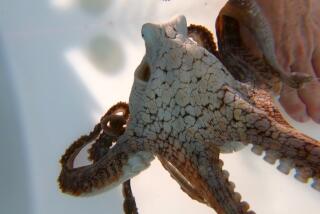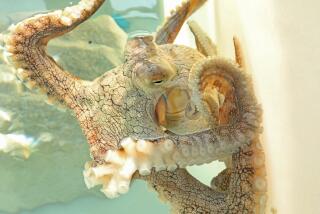Octopus at Cabrillo
- Share via
* As a marine biologist and educator I feel compelled to comment on the actions of the People for Ethical Treatment of Animals in protesting the display of the Octopus dolfleini individual by the Cabrillo Marine Aquarium (March 19). The activists have missed the mark and need to temper their zeal with biological knowledge.
Objections of the animal rights activists to the size of the tank and the conditions under which the octopus is displayed underline their biological naivete. Mary Beth Sweetland, director of the group, decries the condition of the animal as “smashed up . . . between the rock and the glass” and states her desire to see its arms stretched “out to their entirety.” As explained by exhibits director Mike Schaadt, octopuses prefer to shelter in very confined spaces. In fact, these animals are secretive to the extreme, sheltering in lairs--small crevice areas--where they remain unless foraging for prey. These organisms also modify their color pattern and skin texture to mimic their surroundings and remain hidden. A large tank where the animal could “stretch out” would be the last choice of habitat by an octopus.
The staff at the Cabrillo Marine Aquarium have consistently demonstrated concern for the health and well-being of the organisms on exhibit, as well as having excellent understanding of how to educate the public to appreciate and preserve the marine environment. The manner in which this individual was acquired--proprietors of a local fish market chose to donate the octopus to the aquarium rather than butchering and selling it for profit--is in itself proof of the effectiveness of the preservationist efforts of the aquarium and the effect on the fishing community.
RAYMOND A. WELLS Ph.D.
Associate Professor of Biology
Los Angeles Pierce College
* Congratulations to reporter Deborah Schoch for getting everyone’s side of the story about the octopus.
Cabrillo’s main argument seems to be that it is “anthropomorphic” to name the octopus and to believe she would wish to be free. Of course, aquariums avoid naming their captives for the same reason laboratory workers are advised to number, not name, the monkeys, rats, and dogs they see exposed to radiation or force-fed drain cleaner. The goal is to keep people from identifying with the victims--to forget that the animals are feeling beings who, like us, enjoy freedom and pleasure and fight pain, loneliness and death. It is a dishonest tactic.
As for Cabrillo’s offer to release Octavia should she start to self-mutilate from stress--that would be a trifle late, wouldn’t it?
INGRID E. NEWKIRK
Chairperson, PETA
Washington






